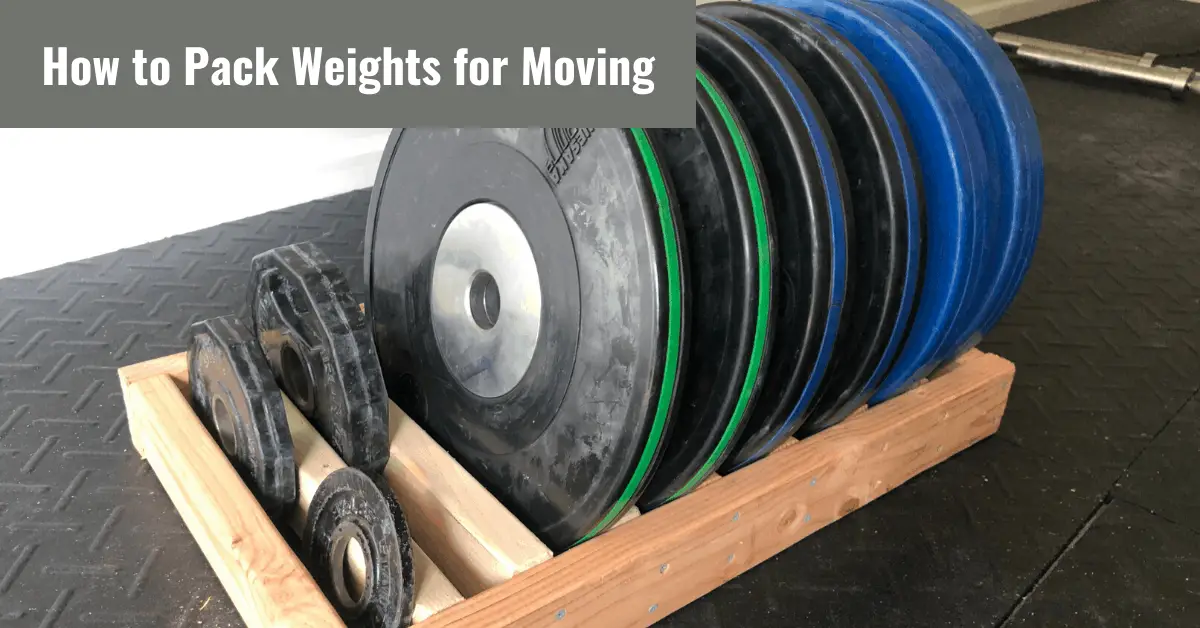How to Pack Weights for Moving

Weights can be a pain to move, especially if you don’t have the right equipment. Here are some tips on how to pack weights for moving:
1. Use sturdy boxes or containers that won’t collapse under the weight.
2. Make sure the containers are securely closed so the weights don’t spill out.
3. Use padding such as bubble wrap or foam to protect the weights and keep them from shifting during transport.
4. Label the boxes or containers so you know where they go and what’s inside.
5. If possible, enlist help from friends or family to lift and carry the heavy boxes or containers.
- Start by packing the heaviest items first
- This will make it easier to stack other boxes on top and will help prevent damage to lighter items
- Pack weights in smaller boxes rather than large ones
- This will make them easier to carry and will help prevent items from shifting during transport
- Use padding material such as bubble wrap or old towels to protect your weights from damage during transit
- Label each box clearly with the contents and destination room so that you can unpack them easily when you arrive at your new home
How to Pack Weights for Shipping
When you are shipping something that is heavy, you need to take special care to pack the item so that it will not be damaged in transit. Here are some tips on how to pack weights for shipping:
1. Use a sturdy box that is designed for shipping heavy items.
Avoid using a flimsy box that could collapse under the weight of the item.
2. Wrap the item in bubble wrap or another type of padding material. This will help protect it from being damaged by shifting during transit.
3. Place the wrapped item in the box and fill any empty space with packing peanuts or other filler material. This will help keep the item from moving around inside the box.
4. Close up the box and seal it with tape.
Make sure to label the box as “Fragile” or “This Side Up” so that handlers know to take extra care with it.
Transporting Dumbbells
If you’re like me, you love lifting weights. But sometimes it’s a pain to have to lug all your equipment to the gym. Here’s how to make transporting dumbbells a breeze!
First, invest in a good quality weightlifting belt. This will help distribute the weight of the dumbbells evenly across your body and make them easier to carry.
Next, get yourself a set of dumbbell racks.
These are great for organizing your weights and keeping them from rolling around in your car or getting lost in your house.
Finally, don’t forget about weightlifting gloves. They’ll help you grip the dumbbells tightly and prevent them from slipping out of your hands.
With these tips, transporting dumbbells will be a breeze!
How to Pack a Treadmill for Moving
Packing a treadmill for moving may seem like a daunting task, but with careful planning and execution it can be done relatively easily. Here are some tips on how to pack a treadmill for moving:
1. Start by disassembling the treadmill.
This will make it much easier to transport and will also help to protect the delicate components from damage during the move.
2. Once the treadmill is disassembled, wrap each component in protective padding or bubble wrap. This will help to keep them safe during transit.
3. Label each piece as you wrap it so that you know where everything goes when it comes time to reassemble the treadmill at your new home.
4. Load the components onto a dolly or other wheeled device for easy transport to the moving truck or storage unit. Be sure to secure them in place so they don’t shift during transport.
How to Package a Treadmill
Assuming you would like a blog post discussing how to package a treadmill for moving:
When it comes time to move your treadmill, you want to be sure that it is properly packaged so that it does not get damaged in transit. Here are some tips on how to package a treadmill for moving:
1. First, disconnect the power cord from the treadmill and wrap it up securely. This will prevent the cord from getting tangled or caught on anything during the move.
2. Next, fold up the treadmill deck and secure it in place with straps or bungee cords.
This will keep it from moving around and getting damaged during transport.
3. If possible, remove the front roller assembly and secure it separately from the rest of the treadmill. This will make packing and unpacking easier and will help protect the roller assembly from damage.
4. Once everything is disassembled and packed up, use furniture pads or blankets to wrap up the treadmill before securing it in place on your moving truck or trailer. This extra layer of protection will help ensure that your treadmill arrives at its new home safely!
How to Pack Kettlebells for Moving
If you’re moving and need to take your kettlebells with you, there are a few things to keep in mind when packing them. First, make sure the kettlebells are clean and dry before packing them. You don’t want them to rust or get damaged during the move.
Second, wrap each kettlebell individually in something soft like a towel or bubble wrap. This will protect them from getting scratched or dented during the move. Finally, pack them in a box that is big enough so they don’t have to be crammed in and can’t move around too much.
With these tips, your kettlebells will make it safely to your new home!
How Do You Travel With Weights?
If you’re looking to add some extra weight to your travel routine, there are a few things you should know. First, check with your airline to see if there are any restrictions on the amount or type of weights you can bring on board. Second, make sure your weights are properly packaged so they don’t shift during transit and damage other luggage.
And finally, be prepared to carry your weights with you through security and to your gate.
Here are a few tips for traveling with weights:
1. Check with your airline before packing any weights in your luggage.
Some airlines have restrictions on the amount or type of weights that can be brought on board.
2. Pack your weights securely so they don’t shift during transit and damage other luggage. Use a sturdy bag or box and pack them tightly so they don’t move around.
3. Be prepared to carry your weights through security and to your gate. Most airports will allow you to bring small handweights in your carry-on bag, but larger ones may need to go in checked baggage.
4. If possible, ship your larger weights ahead of time so you don’t have to lug them around the airport with you.
How Do You Transport Barbells?
There are a few different ways that you can transport barbells. The first way is to use a barbell carrier. This is a device that you can strap onto your back and it will hold the barbell in place while you walk or run.
Another way to transport barbells is to use a weight plate carrier. This is a device that goes around your waist and has handles that you can grip onto while carrying the weight plates. The last way to transport barbells is to use a dumbbell carrier.
This is a device that goes over your shoulder and has handles that you can grip onto while carrying the dumbbells.
How Do You Organize Your Weights?
Organizing your weights is a great way to stay fit and motivated. There are a few different ways to organize your weights, depending on your goals and preferences.
One way to organize your weights is by weightlifting exercises.
You can group similar exercises together, such as chest presses and shoulder presses. This allows you to easily see which exercises target which muscles. Another way to organize your weights is by using weight machines.
This method allows you to focus on one muscle group at a time.
Another popular way to organize your weights is free weights. This gives you the most freedom when it comes to working out, as you can move the weights around however you want.
You can also use dumbbells or barbells for this method.
No matter how you choose to organize your weights, make sure that you have a plan and stick to it! Having a structured workout routine will help you see results more quickly and keep you motivated in the long run.
How Do You Transport a Home Gym?
Assuming you would like tips on how to transport a home gym: 1. Start by disassembling the largest and heaviest equipment in your gym. This could include treadmills, ellipticals, rowing machines, etc.
You will likely need tools to do this, so make sure you have them on hand. Once these pieces are taken apart, label each piece and its corresponding hardware so you can easily reassemble it later. 2. Next, move on to the mid-sized equipment.
Again, disassemble and label everything accordingly. 3. The smaller items in your gym (dumbbells, yoga mats, exercise balls) can usually be packed into boxes or bags. Make sure they are securely packed so they don’t shift around during transport.
4. If you have a home gym that is located in a garage or basement, you may need to rent a moving truck or trailer to get everything moved in one trip. Otherwise, you can load up your car with smaller items and make multiple trips back and forth from your old home to your new one. 5. Once everything is at your new place, start by setting up the large pieces of equipment first.
Conclusion
Packing weights for moving may seem like a daunting task, but it doesn’t have to be! With a little planning and organization, you can get your weights moved without any problems. Here are a few tips on how to pack weights for moving:
-Start by packing the heaviest weights first. This will make it easier to move them later on.
-Use smaller boxes for your heavier weights.
This will make them easier to carry and will prevent them from taking up too much space in the truck.
-Pack your weights securely so they don’t shift during transport. You can use packing peanuts or bubble wrap to keep them in place.
-Label all of your boxes clearly so you know which ones contain your weights. This will make unpacking easier and will ensure that nothing gets lost in the move.
With these tips in mind, packing your weights for moving should be a breeze!





